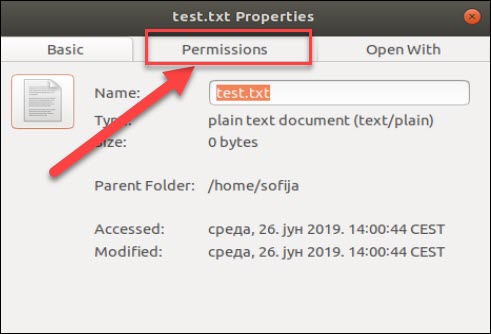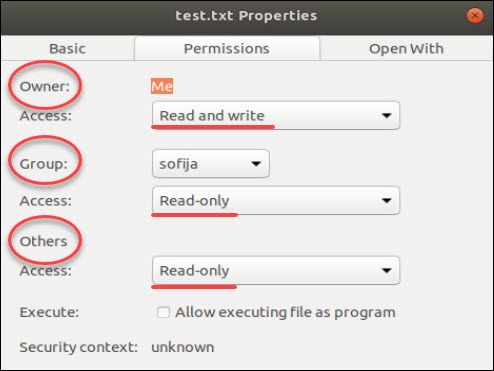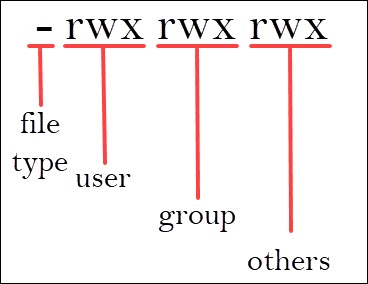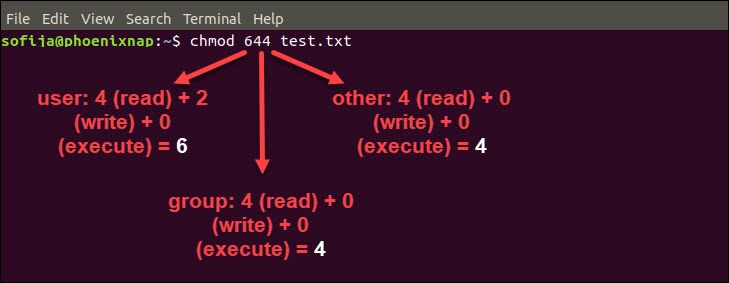How to Give Read Write Permission to Directory in Linux
Introduction
Linux, like other Unix-like operating systems, allows multiple users to work on the same server simultaneously without disrupting each other.
Individuals sharing access to files pose a risk exposing classified data or even information loss if other users access their files or directories. To address this, Unix added the file permission feature to specify how much ability each user has over a given file or directory.
In this tutorial, you volition learn how to view and change file permissions in Linux.

How to View Check Permissions in Linux
To start with file permissions, you have to find the current Linux permission settings. There are 2 options to choose from, depending on your personal preference: checking through the graphical interface or using the command.
Check Permissions using GUI
Finding the file (directory) permission via the graphical user interface is simple.
1. Locate the file you want to examine, right-click on the icon, and select Properties.
2. This opens a new window initially showing Basic information virtually the file.
Navigate to the second tab in the window, labeled Permissions.

3. In that location, you'll see that the permission for each file differs according to three categories:
- Owner (the user who created the file/directory)
- Group (to which the owner belongs to)
- Others (all other users)
For each file, the owner can grant or restrict access to users according to the categories they fall in.

In our example, the owner of the file test.txt has admission to "Read and write", while other members of its group, likewise as all other users, have "Read-only" access. Therefore, they can only open up the file, but cannot make any modifications.
To alter the file configuration, the user can open the drib-down menu for each category and select the desired permission.
Additionally, you tin make the file executable, allowing information technology to run as a program, by checking the Execute box.
Check Permissions in Control-Line with Ls Command
If you prefer using the control line, you can easily find a file'due south permission settings with the ls command, used to list information about files/directories. You can also add together the –l option to the command to see the data in the long list format.
To check the permission configuration of a file, use the command:
ls –fifty [file_name] For instance, the command for the previously mentioned file would be:
ls –l examination.txt 
As seen in the image higher up, the output provides the following data:
- file permission
- the owner (creator) of the file
- the group to which that owner belongs to
- the engagement of creation.
It shows the permission settings, grouped in a string of characters (-, r, w, x) classified into 4 sections:
- File blazon. There are iii possibilities for the blazon. It can either be a regular file (–), a directory (d) or a link (i).
- File permission of the user (owner)
- File permission of the owner's group
- File permission of other users

The characters r, west, and x stand for read, write, and execute.
The categories can accept all 3 privileges, just specific ones, or none at all (represented by –, for denied).
Users that take reading permission can encounter the content of a file (or files in a directory). However, they cannot modify it (nor add/remove files in a directory). On the other manus, those who have writing privileges can edit (add together and remove) files. Finally, being able to execute means the user tin can run the file. This selection is mainly used for running scripts.
In the previous case, the output showed that test.txt is a regular file with read and write permission assigned to the owner, but gives read-only access to the group and others.

Using Chmod Command to Alter File Permissions
Equally all Linux users, you volition at some point need to modify the permission settings of a file/directory. The command that executes such tasks is the chmod command.
The basic syntax is:
chmod [permission] [file_name] There are ii ways to define permission:
- using symbols (alphanumerical characters)
- using the octal note method
Ascertain File Permission with Symbolic Mode
To specify permission settings using alphanumerical characters, you'll need to define accessibility for the user/owner (u), group (g), and others (o).
Type the initial alphabetic character for each class, followed by the equal sign (=) and the start letter of the read (r), write (w) and/or execute (x) privileges.
To ready a file, so it is public for reading, writing, and executing, the command is:
chmod u=rwx,g=rwx,o=rwx [file_name] To set permission as in the previously mentioned exam.txt to be:
• read and write for the user
• read for the members of the group
• read for other users
Use the following command:
chmod u=rw,g=r,o=r test.txt Note: There is no infinite betwixt the categories; nosotros only use commas to separate them.
Another style to specify permission is by using the octal/numeric format. This option is faster, as it requires less typing, although information technology is not equally straightforward as the previous method.
Instead of messages, the octal format represents privileges with numbers:
- r(ead) has the value of 4
- due west(rite) has the value of 2
- (due east)x(ecute) has the value of 1
- no permission has the value of 0
The privileges are summed up and depicted past 1 number. Therefore, the possibilities are:
- 7 – for read, write, and execute permission
- six – for read and write privileges
- v – for read and execute privileges
- 4 – for read privileges
Equally you take to define permission for each category (user, group, owner), the control will include 3 (three) numbers (each representing the summation of privileges).
For case, permit'south expect at the test.txt file that we symbolically configured with the chmod u=rw,g=r,o=r test.txt command.
The same permission settings can be defined using the octal format with the command:
chmod 644 test.txt 
Ascertain File Permission in Octal/Numeric Mode
Note: If y'all need a more than in-depth guide on how to use Chmod In Linux to change file permissions recursively, read our Chmod Recursive guide.
Changing User File and Group Ownership
Aside from changing file permissions, you may come across a situation that requires changing the user file ownership or even group ownership.
Performing either of these tasks requires you lot first need to switch to superuser privileges. Use one of the options outlined in the previous passage.
To change the file ownership utilize the chown command:
chown [user_name] [file_name] Instead of [user_name] type in the proper name of the user who volition be the new possessor of the file.
To change the group ownership blazon in the following command:
chgrp [group_name] [file_name] Instead of [group_name] blazon in the proper name of the group that will exist the new possessor of the file.
Determination
Learning how to check and change permissions of Linux files and directories are basic commands all users should master. To change file'southward grouping permissions, you might find helpful our article on how to employ the chgrp command.
No affair whether you prefer using the GUI or command-line, this article should assistance you lot better understand how to use file permissions.
Was this article helpful?
Yes No
Source: https://phoenixnap.com/kb/linux-file-permissions
0 Response to "How to Give Read Write Permission to Directory in Linux"
Postar um comentário